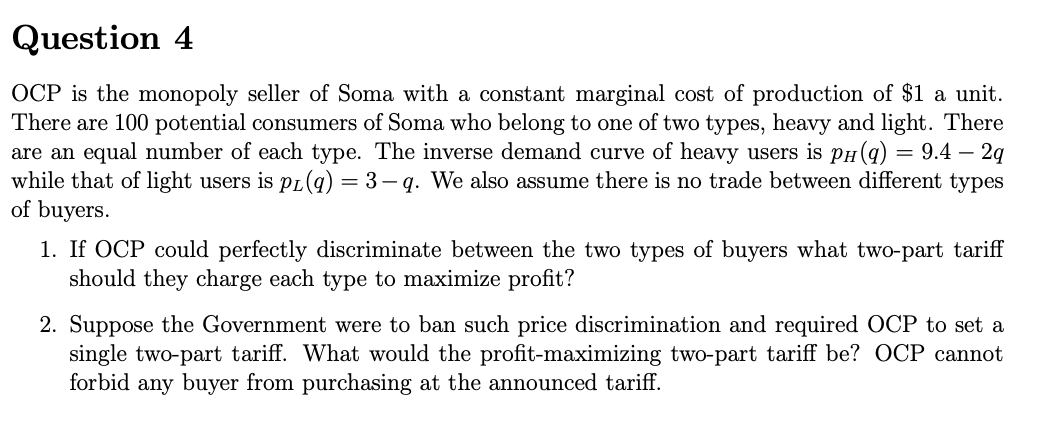Question 4 OCP is the monopoly seller of Soma with a constant marginal cost of production of $1 a unit. There are 100 potential consumers of Soma who belong to one of two types, heavy and light. There are an equal number of each type. The inverse demand curve of heavy users is pH(q) = 9.4 – 2q while that of light users is pL(q) = 3– q. We also assume there is no trade between different types of buyers. 1. If OCP could perfectly discriminate between the two types of buyers what two-part tariff should they charge each type to maximize profit? 2. Suppose the Government were to ban such price discrimination and required OCP to set a single two-part tariff. What would the profit-maximizing two-part tariff be? OCP cannot forbid any buyer from purchasing at the announced tariff.
Question 4 OCP is the monopoly seller of Soma with a constant marginal cost of production of $1 a unit. There are 100 potential consumers of Soma who belong to one of two types, heavy and light. There are an equal number of each type. The inverse demand curve of heavy users is pH(q) = 9.4 – 2q while that of light users is pL(q) = 3– q. We also assume there is no trade between different types of buyers. 1. If OCP could perfectly discriminate between the two types of buyers what two-part tariff should they charge each type to maximize profit? 2. Suppose the Government were to ban such price discrimination and required OCP to set a single two-part tariff. What would the profit-maximizing two-part tariff be? OCP cannot forbid any buyer from purchasing at the announced tariff.
Chapter14: Monopoly
Section: Chapter Questions
Problem 14.6P
Related questions
Question

Transcribed Image Text:Question 4
OCP is the monopoly seller of Soma with a constant marginal cost of production of $1 a unit.
There are 100 potential consumers of Soma who belong to one of two types, heavy and light. There
are an equal number of each type. The inverse demand curve of heavy users is pH(q) = 9.4 – 2q
while that of light users is pL(q) = 3– q. We also assume there is no trade between different types
of buyers.
1. If OCP could perfectly discriminate between the two types of buyers what two-part tariff
should they charge each type to maximize profit?
2. Suppose the Government were to ban such price discrimination and required OCP to set a
single two-part tariff. What would the profit-maximizing two-part tariff be? OCP cannot
forbid any buyer from purchasing at the announced tariff.
Expert Solution
This question has been solved!
Explore an expertly crafted, step-by-step solution for a thorough understanding of key concepts.
This is a popular solution!
Trending now
This is a popular solution!
Step by step
Solved in 3 steps with 2 images

Knowledge Booster
Learn more about
Need a deep-dive on the concept behind this application? Look no further. Learn more about this topic, economics and related others by exploring similar questions and additional content below.Recommended textbooks for you


Managerial Economics: Applications, Strategies an…
Economics
ISBN:
9781305506381
Author:
James R. McGuigan, R. Charles Moyer, Frederick H.deB. Harris
Publisher:
Cengage Learning



Managerial Economics: Applications, Strategies an…
Economics
ISBN:
9781305506381
Author:
James R. McGuigan, R. Charles Moyer, Frederick H.deB. Harris
Publisher:
Cengage Learning


Managerial Economics: A Problem Solving Approach
Economics
ISBN:
9781337106665
Author:
Luke M. Froeb, Brian T. McCann, Michael R. Ward, Mike Shor
Publisher:
Cengage Learning

